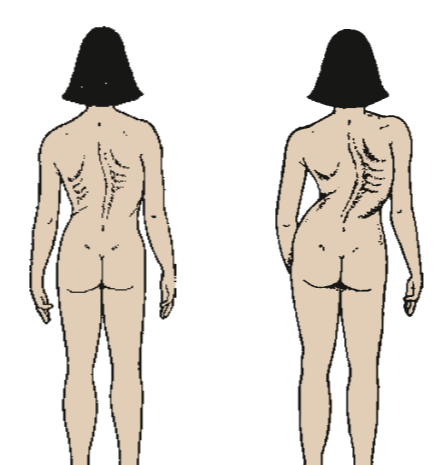Scoliosis
Content of This Page
1- Introduction
2- Causes
3- Symptoms
4- Types of Disease
5- Treatment
6- What Should You Avoid
Introduction
Scoliosis is a condition characterized by an abnormal lateral curvature of the spine. While some degree of spinal curvature is normal, scoliosis involves a more pronounced curve that can affect the spine’s alignment and overall posture. It can vary in severity and may develop in different parts of the spine.

Causes
1. Idiopathic Scoliosis
- Unknown Cause: The exact cause is unknown, though it is thought to involve genetic and environmental factors.
- Genetic Factors: Family history may play a role, suggesting a genetic predisposition.
- Growth Spurt: Often occurs during the adolescent growth spurt, which may trigger or accelerate the condition.
2. Congenital Scoliosis
- Spinal Malformations: Caused by abnormalities in the formation of the spine during fetal development.
- Causes:
- Vertebral Anomalies: Vertebrae may be fused or missing, leading to abnormal spinal curvature.
- Segmental Defects: Issues with the segmentation of vertebrae during development.
3. Neuromuscular Scoliosis
- Neuromuscular Conditions: Resulting from diseases or conditions that affect the muscles and nerves controlling the spine.
- Associated Conditions:
- Cerebral Palsy: Muscle imbalances and abnormal muscle tone can contribute to scoliosis.
- Muscular Dystrophy: Progressive muscle weakness affects spinal alignment.
- Spina Bifida: A spinal cord defect that can lead to spinal deformities.
4. Degenerative Scoliosis
- Aging-Related Changes: Develops as a result of the natural aging process and degenerative changes in the spine.
- Causes:
- Disc Degeneration: Breakdown of spinal discs can lead to uneven wear and curvature.
- Osteoarthritis: Joint degeneration and spinal instability contribute to scoliosis.
- Osteoporosis: Loss of bone density can lead to spinal deformities and curvature.
5. Functional Scoliosis
- Secondary to Other Conditions: Not a true spinal curvature but a result of another condition or imbalance.
- Causes:
- Leg Length Discrepancy: Uneven leg length can cause compensatory spinal curvature.
- Muscle Spasms: Severe muscle spasms or imbalances may lead to a temporary spinal curve.
- Postural Imbalances: Poor posture or uneven weight distribution can cause functional scoliosis.
Symptoms
- Uneven Shoulders: One shoulder may be higher than the other.
- Uneven Waist: One side of the waist may appear higher or more prominent.
- Prominent Ribs: One side of the ribcage may stick out more than the other.
- Back Pain: In some cases, scoliosis can cause discomfort or pain, especially in adults with degenerative scoliosis.
- Postural Changes: Noticeable changes in posture or alignment.
Types of Disease
Idiopathic Scoliosis
- Description: The most common type, where the cause is unknown. It typically appears during adolescence and can progress over time.
- Subtypes:
- Adolescent Idiopathic Scoliosis: Occurs in children between ages 10 and 18, usually during growth spurts.
- Juvenile Idiopathic Scoliosis: Develops in children younger than 10 years old.
- Infantile Idiopathic Scoliosis: Appears in children younger than 3 years old.
Congenital Scoliosis
- Description: Results from a malformation of the spine that occurs during fetal development. It is present at birth and can progress as the child grows.
- Causes: Abnormalities in the formation of vertebrae, such as fused or missing vertebrae.
Neuromuscular Scoliosis
- Description: Develops as a result of neuromuscular conditions that affect the muscles and nerves controlling the spine.
- Associated Conditions: Cerebral palsy, muscular dystrophy, spina bifida.
Degenerative Scoliosis
- Description: Occurs in adults, usually due to the degeneration of spinal discs and joints with age. It may be associated with conditions like osteoarthritis or osteoporosis.
- Impact: Can result in uneven wear and tear on the spine, leading to curvature.
Functional Scoliosis
- Description: Not a true spinal curvature but a result of an imbalance or deformity elsewhere in the body, such as leg length discrepancy or muscle spasms.
- Reversibility: The curve may correct itself when the underlying cause is treated.
Treatment
Observation
- Approach: Regular monitoring may be recommended for mild scoliosis, especially if it is not causing symptoms or affecting function.
- Frequency: Regular check-ups to monitor progression, particularly during growth spurts.
Bracing
- Approach: Used to prevent further curvature progression in growing children and adolescents.
- Types: Various types of braces, such as the Boston brace or Milwaukee brace, may be used depending on the curvature location and severity.
Physical Therapy
- Approach: Exercises and stretches can improve posture, strengthen muscles, and manage pain. It may not correct scoliosis but can help manage symptoms and improve function.
- Focus: Core strengthening, flexibility exercises, and postural training.
Medications
- Approach: Pain relief and management of associated symptoms.
- Types: Nonsteroidal anti-inflammatory drugs (NSAIDs) or other pain medications.
Surgical Intervention
- Approach: Considered for severe scoliosis or when conservative treatments are ineffective.
- Types: Spinal fusion surgery to correct and stabilize the curvature. Surgical options vary depending on the severity and location of the curve.
What Should You Avoid
- Early Detection: Regular check-ups during growth periods to detect scoliosis early and monitor its progression.
- Postural Awareness: Maintaining good posture and engaging in physical activity can support spinal health, though they may not prevent scoliosis.